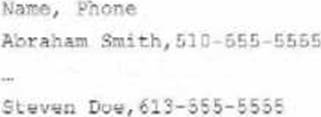Talend Data Integration Developer Talend Data Integration Certified Developer Exam Online Training
Talend Data Integration Developer Online Training
The questions for Data Integration Developer were last updated at Dec 18,2025.
- Exam Code: Data Integration Developer
- Exam Name: Talend Data Integration Certified Developer Exam
- Certification Provider: Talend
- Latest update: Dec 18,2025
A data professional would like to combine multiple data sources into a relational database to improve their business efficiency.
Which data integration initiative can help them achieve this?
- A . Manually collect the data from various source interfaces, then clean and combine the data into one warehouse.
- B . Use a middleware application that acts as a mediator to normalize data and bring it into a master data pool.
- C . Create a data warehouse to run queries, reports, and analyses to retrieve data in a consistent format.
- D . leverage data lakes to manage complex and massive volumes of structured and unstructured data.
Which tab provides lines of code generated for the selected component in Telend Studio?
- A . Jobscript tab
- B . Code viewer tab
- C . Run consult
- D . Outline tab
Which section in Talend Studio allows you to graphically connect components in a Job to run a dataflow process?
- A . Design workspace
- B . Component view
- C . Repository
- D . Code
Which templates allow you to create ready-to-run Jobs in Talend Studio? Choose 2 answers
- A . Table to Table
- B . FileToDatabase.
- C . TahleToFile
- D . JobletToFile
Which element carries data between two components in a Job?
- A . Sublob
- B . Link
- C . Trigger
- D . Row
Which statement is true about the Sync columns button on the Basic settings tab of the Component view? Choose 2 answers
- A . Retrieves and synchronizes the output file schema with the input file schema for tFileOutputed limited.
- B . Retrieves the schema of the current component to match the Next component
- C . Retrieves the schema from the input component connected in the lob.
- D . Retrieves and synchronizes the output schema with the input schema for tJavaRow.
In some instances, after applying changes to a component schema, you are asked if you would like to propagate the changes.
What is the significance of this prompt?
- A . Confirm Out you want to apply the schema, changes to the previous component in the Job.
- B . Confirm That you want to apply the schema changes to the selected component.
- C . Confirm that you want to apply the schema changes to both the previous and next components in the Job.
- D . Confirm that you want to apply the schema changes to the next component in the Job.
Using the following input file format as an example:

Which tFileinputDelimted component parameters should you configure to parse the input file correctly? Choose 3 answers
- A . Limit
- B . Schema
- C . Field separator
- D . Footer
- E . Header
Which methods car you use to specify the schema in a tFilelnputDelimited component? Choose 3 answers
- A . Drag a generic schema metadata item onto the Designer.
- B . Add the component then drag and drop a generic schema metadata item onto the component.
- C . Add the schema to the component using the Schema Editor
- D . Drag a File delimited metadata item from the Repository onto the design workspace.
- E . Add the component, open the Component view, select the Built-in schema type, then click the Edit schema button.
You are using the tMap component to configure a mapping.
What do the tables on the left side of the Map Editor window represent?
- A . Explosions to apply to the input data
- B . Schemas of the output rows
- C . Schemas of the input rows
- D . Expression to apply to the output data
Latest Data Integration Developer Dumps Valid Version with 55 Q&As
Latest And Valid Q&A | Instant Download | Once Fail, Full Refund

